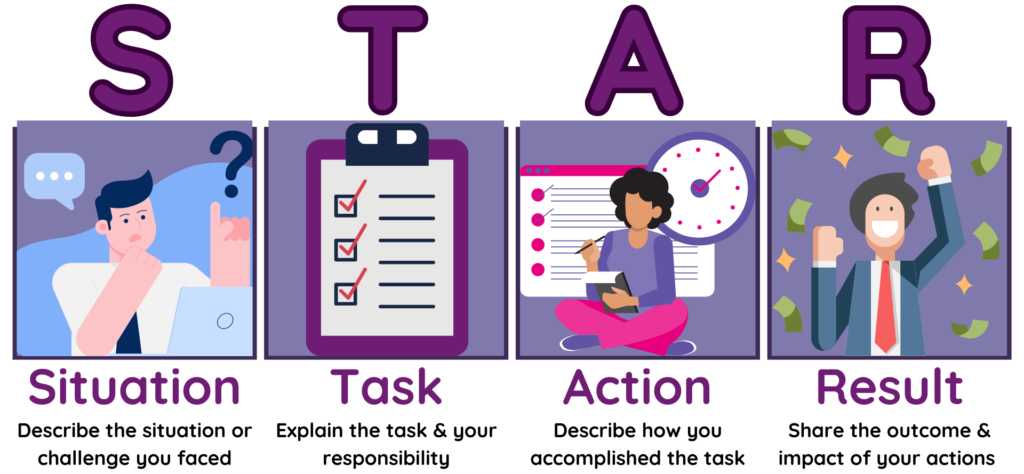Job interviews can be nerve-wracking, especially when faced with behavioral questions like,
“Can you give me an example of a time you solved a problem?” or “Describe a situation
where you had to work under pressure.” The STAR method is an excellent tool to structure
your answers in a clear, concise, and compelling way. Here’s everything you need to know
about the STAR technique and how to use it effectively during your next interview.
What is the STAR Method?
The STAR method is a structured framework for answering behavioral interview questions.
STAR stands for:
- Situation: Describe the context or background of your story.
- Task: Explain the challenge or responsibility you faced.
- Action: Detail the specific steps you took to address the situation.
- Result: Share the outcome of your actions, including any measurable impact.
This format helps you present your experiences in a logical and engaging way, making it
easier for interviewers to understand the value you bring to the table.
Why Use the STAR Method?
- Clarity: It ensures your answer is structured and easy to follow.
- Focus: Keeps your response relevant to the question asked.
- Impact: Highlights the results of your efforts, showcasing your contributions.
How to Apply the STAR Technique
Here’s a step-by-step guide to using the STAR method during your interview:
1. Analyze the Question
Behavioral questions often start with phrases like:
- “Tell me about a time when…”
- “Describe a situation where…”
- “Give an example of…”
Identify the key skill or competency the question is targeting, such as problem-solving,
teamwork, or leadership.
2. Choose the Right Example
Pick a relevant example from your past experiences that showcases your skills and aligns with
the job requirements. It’s okay to draw from work, school, or volunteer experiences as long as
the story demonstrates your qualifications.
3. Structure Your Answer Using STAR
Use the STAR framework to organize your response:
- Situation: Start by setting the stage. Briefly explain the context of your story.
Example: “In my previous role as a project manager, our team faced a tight deadline to deliver a new product feature.” - Task: Clearly outline the challenge or goal you needed to address.
Example: “My responsibility was to coordinate the team and ensure we met the deadline without compromising quality.” - Action: Focus on the specific actions you took to resolve the issue or achieve the goal. Highlight your skills and contributions.
Example: “I restructured the workflow, prioritized tasks, and held daily check-ins to track progress. I also stepped in to help with coding during critical stages.” - Result: End with the outcome, emphasizing positive and measurable results.
Example: “We successfully launched the feature on time, resulting in a 15% increase in customer satisfaction and meeting the company’s quarterly goals.”
4. Practice Your Delivery
Rehearse your STAR responses to ensure they sound natural and confident. Avoid
memorizing them word-for-word, as this can make you seem robotic. Instead, focus on key
points to keep your answers authentic.
Example STAR Response
Question: “Can you tell me about a time when you had to resolve a conflict at work?”
Situation: “In my role as a team lead, two team members had a disagreement over how to
prioritize tasks for an important project.”
Task: “I needed to mediate the situation and ensure the project stayed on track.”
Action: “I scheduled a meeting with both team members to understand their perspectives. I
encouraged open communication and helped them align their priorities with the project’s
objectives. I also proposed a compromise that incorporated elements of both their
suggestions.”
Result: “As a result, the team worked more cohesively, and we completed the project ahead
of schedule. Both team members appreciated the mediation process, and it strengthened our
collaboration moving forward.”
Tips for Success with the STAR Method
- Be Specific: Avoid vague responses. Provide enough detail to make your story compelling.
- Focus on Your Role: Emphasize what you did, even if the task was part of a team effort.
- Quantify Results: Whenever possible, include metrics to demonstrate your impact.
- Stay Concise: Aim to keep your answers within 1-2 minutes.
Common STAR Questions to Prepare For
Here are some behavioral questions you can practice with:
- “Tell me about a time you led a team to success.”
- “Describe a situation where you had to handle a difficult client.”
- “Give an example of a time when you missed a deadline and how you handled it.”
- “Tell me about a challenge you faced and how you overcame it.”
Using the STAR method allows you to present your experiences in a professional and
impactful way. By preparing thoughtful examples and practicing your delivery, you’ll be
ready to ace any behavioral question that comes your way. Remember, interviews are not just
about showcasing your skills—they’re about telling your story effectively!

